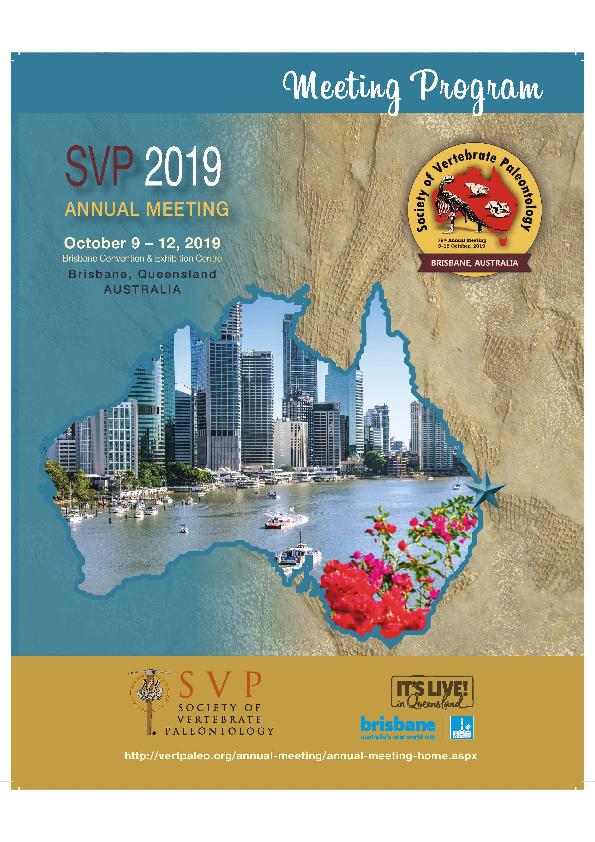Mostrar el registro sencillo del ítem
dc.contributor.author
Beron Vera, Barbara

dc.contributor.author
Scarano, Alejo Carlos

dc.date.available
2022-06-16T14:09:26Z
dc.date.issued
2019
dc.identifier.citation
Evolutionary trends of Protypotherium lineage throughout the Miocene-Pliocene of South America; 79th Annual Meeting; Brisbane; Australia; 2019; 211-212
dc.identifier.uri
http://hdl.handle.net/11336/159932
dc.description.abstract
Protypotherium (lnteratheriinae, Notoungulata, Mammalia) is a well-known and very diverse genus of extinct native ungulates of South America, widely distributed from southern to middle latitudes of Argentina, Chile, and Bolivia. This genus exhibits distinctive species throughout the different biozones from the Miocene t0 Pliocene that display an interesting size pattern. Three species from the late Early Miocene, P. attenuatum (small), P. pmemtilum (medium), and P. australe (large); two species from the Middle to early Late Miocene, P. endiadys (small) and P. colloncurensis (large); two species from the Late Miocene, P. minutum (small) and P. distinctum (large); and only one species from Late Miocene-Plioeene, P. antiquum (large). The large sample of specimens studied during several years Of research allow to us to analyze the shape and size of upper and lower molars for all the species of Prolypotherium, in order to test the hypothesis of reduction of size ranges preserving a general tooth morphology as a response to climate deterioration. Elliptic Fourier analyses (EFA) were used to capture the shape of the occlusal morphology and the centroid size (CS) was also retained for subsequent analyses. Our results demonstrate that: 1) in general, a similar morphological tooth pattern is Observed among all species from Miocene t0 Pliocene; 2) there is a tendency to increase the size from the smallest species of the late Early Miocene (e.g., P. australe) t0 the largest one in the Late Miocene-Pliocene (P. antiquum); 3) tooth shape variation is not associated With a change in size (CS), both in upper and lower molars and between small and large species; 4) a decrease in the number of species is recorded from three in the early Miocene to one in the Late Miocene-Pliocene. This striking pattern could be correlated With a global trend to lower temperatures, Which indicates a deterioration of paleoenvironmental conditions. In South America, a markedly descend of temperature occurred during Miocene times that is also testified by paleo?ora and the marine environmental. Given this paleoenvironmental context, a successful conservative tooth pattern, together With an increase of size and a reduction in number of species were the main evolutionary and ecological tendencies accounted in Protypotherium from the Miocene to Pliocene.
dc.format
application/pdf
dc.language.iso
eng
dc.publisher
Society of Vertebrate Paleontology

dc.rights
info:eu-repo/semantics/openAccess
dc.rights.uri
https://creativecommons.org/licenses/by-nc-sa/2.5/ar/
dc.subject
NOTOUNGULATES
dc.subject
ANÁLISIS DE FOURIER
dc.subject
MASA CORPORAL
dc.subject
DENTINCIÓN
dc.subject.classification
Paleontología

dc.subject.classification
Ciencias de la Tierra y relacionadas con el Medio Ambiente

dc.subject.classification
CIENCIAS NATURALES Y EXACTAS

dc.title
Evolutionary trends of Protypotherium lineage throughout the Miocene-Pliocene of South America
dc.type
info:eu-repo/semantics/publishedVersion
dc.type
info:eu-repo/semantics/conferenceObject
dc.type
info:ar-repo/semantics/documento de conferencia
dc.date.updated
2022-06-15T15:49:31Z
dc.journal.pagination
211-212
dc.journal.pais
Estados Unidos

dc.journal.ciudad
Maryland
dc.description.fil
Fil: Beron Vera, Barbara. Consejo Nacional de Investigaciones Científicas y Técnicas. Centro Científico Tecnológico Conicet - Patagonia Norte. Centro de Investigación Esquel de Montaña y Estepa Patagónica. Universidad Nacional de la Patagonia "San Juan Bosco". Centro de Investigación Esquel de Montaña y Estepa Patagónica; Argentina
dc.description.fil
Fil: Scarano, Alejo Carlos. Consejo Nacional de Investigaciones Científicas y Técnicas; Argentina. Universidad Nacional de La Plata. Facultad de Ciencias Naturales y Museo. Departamento Científico de Paleontología de Vertebrados; Argentina
dc.relation.alternativeid
info:eu-repo/semantics/altIdentifier/url/https://vertpaleo.org/future-past-meetings/
dc.conicet.rol
Autor

dc.conicet.rol
Autor

dc.coverage
Internacional
dc.type.subtype
Reunión
dc.description.nombreEvento
79th Annual Meeting
dc.date.evento
2019-10-09
dc.description.ciudadEvento
Brisbane
dc.description.paisEvento
Australia

dc.type.publicacion
Book
dc.description.institucionOrganizadora
Society of Vertebrate Paleontology
dc.source.libro
79th Annual Meeting: Asbtracts of papers
dc.date.eventoHasta
2019-10-12
dc.type
Reunión
Archivos asociados
